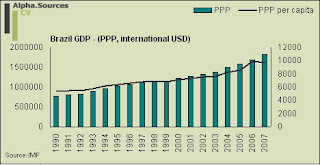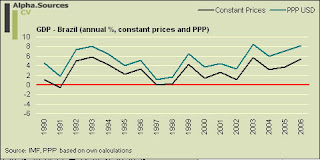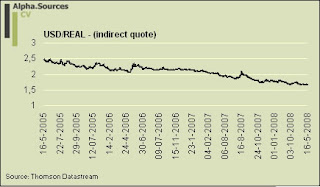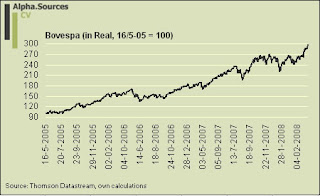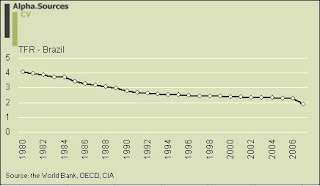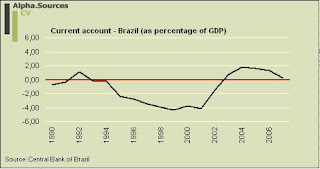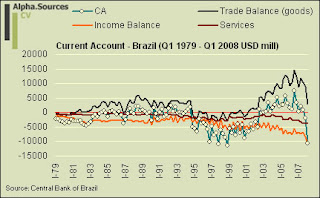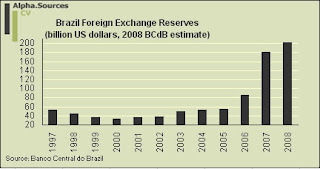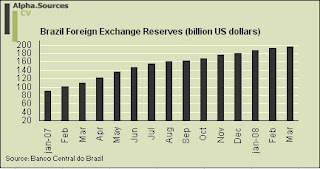Brazil's Economy - Not Emerging Anymore?
[This note also features over at Global Economy Matters and as per usual when I do these things it is quite big. A list of references will follow later]
Brazil is interesting; not only because of its fabulous nature, its rhytmic and musical heritage, and its (alleged) repository of beautiful women but also because of the position it commands in the global economy, the latter topic being the focus of this note. Consequently, Brazil's economy represents an excellent point of departure for the evaluation of many high strung discourses in the context of the global economy and her financial markets. These discourses include the debate on de-coupling/re-coupling, global inflation, Bretton Woods II/global imbalances, global liquidity/SWFs among other things. In the following, I will argue why I am very constructive on the upside potential for Brazil's economy as well as I will try to untangle (as I have tried so many times before) some of these before mentioned talking points in the context of the global economy and Brazil.
Perhaps the most telling sign of Brazil's increasing status was the recent announcement by Brazil's National Petroleum Agency (ANP) that a new oil field (Carioca) had been discovered potentially holding as much as 33 billion barrels of oil. Coupled with the discovery last year of the Tupi field promising to deliver about 7 billion barrels of oil this could potentially fast forward Brazil up through the ranks of global oil producing nations. The new found oil prowess even prompted the president Lula da Silva recently to suggest that Brazil enter OPEC. These oil discoveries come at a near perfect time for Brazil who thus seems set not only to enjoy the upward march of commodities such as beef, oranges, iron ore but now also the black gold. Of course, the set up of a proper supply chain in the context of oil production takes time and it will take at least one year before we see the first barrils rolling in from Tupi not to speak of Carioca. However, Petrobras (Petroleo Brasileiro SA) is not sitting idle and the effects of Brazil's oil discoveries are already rippling through the market. Extraordinary evidence of this was delivered in the context of Petrobras' demand for the world's deepest-drilling offshore rigs to put action behind the recent discoveries. Petrobras is rumored to be hawking as much as 80% of global capacity as a function of the company's demand for deep drilling rigs and given the fact that these things don't exactly come off the shelf with the same ease as flat screens it will take some time for supply to respond to the increased demand thus pushing up rent for these vessels.
In many ways, as Edward also hints in a recent article the oil discoveries mentioned above represent a good initial image of Brazil's growing role in the global economy. Petrobras thus projects investments to the tune of 112 billion USD between 2008 and 2012 which, if realized, are sure to calm down even the most careful treasurer in the Brazilian finance ministry.
Thus assured of Brazil's importance we should take a few steps back and have a look at the historical economic performance of Brazil, how it got to where it is today and where it is likely to go in the future?
It does not take much of a macroeconomist to see how the stories above tell a story of rapid economic development. Obviously, it is difficult to make solid conclusions solely on the basis of growth figures but as can readily be observed Brazil is moving up in the world. Especially, the figures for PPP adjusted GDP are interesting since they show how Brazil is steadily and unrelentlessly becoming an ever larger share of global GDP. The inflation figure also shows that almost a decade's worth of rampant inflation has now receded to much more comfortable levels. As for the allure of Brazilian asset markets the last figure just about sums it up. Over the three year period a US investor investing 1 mill USD the 16th of May 2005 would have been able to walk away with just shy of 4.5 mill USD the corresponding date 2008 (note that the exchange rate is with our US friend here too). Of course, such examples are not kosher as we are not looking at risk (e.g. standard deviation or global beta) but the rate of expansion in the main stock index is still quite remarkable even border lining to a bubble if you look at the growth rate alone. This role is of course shared by the other usual suspects who make up the notorious BRIC group so famously coined by Goldman Sachs. I would not want to take anything away from GS here but simply note that the BRIC narrative is not exactly fitting for what is happening in the global economy. It is indeed true that the four economies are amongst the fastest growing economies of the world but they are very difficult in terms of structural setup which tends to blur the analysis. Specifically, I would distinguish between Brazil, India, and China on one side and Russia on the other. Soon in fact China may join Russia's side of the fence if the inflation bonfire currently experienced proves inextinguishable.
Brazil's rise not only in terms of GDP at constant prices but also in PPP terms cuts right across the whole debate on de-coupling which at times has developed into a rather badly played football match between the US and Europe. In this way, I never really was a fan of the original idea of de-coupling whereby the Eurozone ascended to take over from the US as the new global economic power train (and reserve currency repository). I simply think that this debate was principally flawed in its foundation. As such, it was never about whether the Dollar should fall or not, but against who and what. What we are currently observing in the global economy is then a process of recoupling of unprecedented proportions. Basically, the big economies of Latam and Asia not only want to be rich on population but also on economic wealth and what we are observing across the global economic edifice is the unwinding of the post WWII imbalances in which one half of the world got economic growth whereas the other got population growth. Brazil's rise in terms of purchasing power is a clear sign of this and in this light, the rise of big economies such as China, India, Brazil, and Turkey will change the tectonic plates of the global economy. Ultimately this process may be a difficult transition for the global economy and in particular for those countries yielding their ranks but it should not be lamented.
Too Much of a Good Thing?
Alas, this global process of re-coupling is not a linear and steady process and it is getting clouded by the Bretton Woods II edifice in which Asian economies alongside petro exporters maintain a fixed exchange rate policy to the US accumulating vast reserves in the process. Brazil finds itself right smack in the middle on an unprecedented global hunt for nominal yield as excess liquidity, wide global interest rate differentials, and key fixed exchange rate regimes determine the global flow of funds. Especially, as the US economy falters, the shift of capital flow to snub the return to negative real yields in the US is piling the pressure on asset markets in countries who maintain open capital and financial accounts. This has prompted many analysts to lament the inflation targeting policy of the central bank as it serves to keep nominal interest rates too high thus sucking in too much capital for the economy’s own good. The recent lingering backdrop of the external balance into deficit (see below) is among other things used as ammunition. Current interest rates are at a hefty 11.75% and it does not take much financial literacy to spot the carry trading (see appendix) plays available. Recently, Antonio Carlos Lemgruber voiced a similar critique in the context of RGE's Latin America monitor. Mr. Lemgruber's main argument is pinned on one of the most illusive of economic concepts in the form of the output gap which measures the divergence between the potential output and actual output. According to him Brazilian monetary authorities are too pessimistic on behalf of the economy's capacity to grow. Currently the interest rate is set on the basis of a potential growth rate of 3-4% while Lemgruber believes it to more like 7%. This would require a lower nominal interes rates to keep the economy growing without stoking 'inflationary pressures.' In terms of the actual numbers for potential output I tend to side with Lemgruber but we need to realize, I feel, that the measure of capacity in an economy such as Brazil's is tremendously difficult. The reason for this is simple and relates to the process known as the demographic dividend.
This note shall not dwell extensively by the pace of the demographic transition in Brazil but simply note that Brazil quite like almost all of the other socalled emerging economies is closing the demographic gap with the rest of the OECD quite rapidly. The figure below shows this process quite neatly even though we should be very careful about extrapolating on general population momentum on the basis of fertility numbers.
As can be observed there is some uncertainty as regards to the pace of fertility decline going into the 21st century. What can see however is that Brazil is steadily nearing the sub-replacement level and based on expectations we should expect her to continue. In fact, according to the US Census Bureau's database Brazil's TFR is already below replacement levels at this point (1.86) although a more detailed analysis is needed to tell for sure. This means that the demographic dividend by which falling fertility provides a period in which the dependency ratio of the economy declines is now occurring in the context of Brazil. However, we also know that there are no free lunches and the favorable environment provided by the DD is also followed by a less favorable environment as the age dependency steadily rises as well as the productive profile of the country shifts as the age structure effects ripple through. In this light, the DD becomes an opportunity to lock-in the highest possible growth path and this is exactly what Brazil now need. It is in this specific context that I see the difficulties in estimating capacity in Brazil since no one really knows at this point. We know however, that it is growing and thus that it is probably somewhat larger than the 3-4% currently fielded by the central bank. The debate thus shores up in a somewhat circular reasoning exercise. There is no doubt that the increasing purchasing power of Brazil's currency (more about that below) is warranted (see Macro Man for a semi-empirical account of this). But in a world where yield is the name of the game inflation targeting policies become virtual magnets for funds at the same time as the policy itself brings little relief in terms of inflation which springs from external headline pressures. Lowering the rates could help here but it would hardly stem the flow of carry trades and at the moment inflationary tendencies does not seem to warrant such moves. The crucial question is simply whether Brazil's fundamental growth path and inherent ability to create investment opportunities merit a base return of 11.75% (or similar)? In reality of course this is the same discussion as with the output gap as well as it is a discussion of what the base nominal rate actually consists of in terms of a measure of domestic investment capacity (i.e. a demand perspective) and/or foreign investors view on business risk (supply side perspective). We should also remember that the PPP model is an equilibrium model which predicts parity driven by inflation differentials. This is very difficult to discern in the context of Brazil though if we accept the premises that the economy itself is in a transition. More importantly, how well does the PPP fit the actual realities of the global economy? As recent as yesterday Stephen Jen wrote a neat piece in which he argued that currency appreciation might actually be inflationary in the current context of the global yield hunt. Through such a lens PPP hardly seems to be the right measure to gauge the ‘true’ value of the currency. Yet, as we turn to the next subject we shall see that the real issue here is not so much whether to be optimistic or pessimistic on Brazil's future economic prowess but rather whether Brazil should submit itself to rules of the game which would entail a transition towards a growth path by which internal investment exceeds internal savings, on a flow basis, ... in short, how much of a negative external balance can and should Brazil run?
As I will sketch out below I believe that Brazil can now, in broad terms, go two ways and it is in the distinct interest for Brazil herself and the global economy that Brazil is encouraged on to one road rather the other.
Letting the Capital Flow?
Consequently as we home in on the issues of global imbalances, Bretton Woods II, excess liquidity Brazil becomes an important litmus test for the choices many big countries with comparatively young populations face. Let us begin with the visual inspection to get us off the mark.
As can be observed the appreciation of the Real and the subsequent increase in purchasing power has resulted in a deterioration of Brazil's external balance although as I have argued before endogeous life cycle effects which spring from demographics may be equally as important. The trade balance in goods is not yet in the red most likely due to the push from commodities; if Brazil is now set to enjoy an oil windfall the trade balance in goods can perhaps be kept in the plus. The current account however is now firmly in negative on the back of deficit in services trade and the income balance. The latter subcomponent is not without interest here since a negative income balance is exactly what we would expect in the context of a country such as Brazil with a comparatively young population. If we look at the financing of the deficit we can see that the inflow of FDI has been steadily positive for a number of years which provides initial support for a solid base of financing. Portfolio investments have been somewhat more volatile which is quite as expected but the recent years seem to have seen a sustained and increasing inflow. After all, if I can make a graph of Bovespa such as the one above, so can others. The recent retrenchment of inflows seems to have come as a result of the jitter in credit markets. In this light what we have now is an important test case in terms of just how much capital that will leave Brazil in the context of global turmoil in credit markets. Conventional wisdom would hold that Brazil should suffer an exodus of capital but I am not so sure. In fact, given the amount of liquidity bouncing around I don’t see where portfolio managers would put their money albeit of course the recent surge of commodities in some way should be seen as a flight from traditional risky assets.
In terms of the amount of carry trade which seems to worry many an observer I have to note upfront that this is really difficult to read out of macroeconomic data. The real juicy data series here would be high frequency FX data on retail and institutional positions in the spot market. Having said that loans have indeed recently been an increasing part of the financing of the Brazilian external deficit which may hint to carry trading positions. If we further consult the subcomponents in the form of short term loans and currency deposits there seems to be an increasing volatility which may hint to a lot of activity on the short end of the maturity curve. This could be akin to carry trading activity. The big spike which shows a large repatriation of funds could be indication of unwinding of short positions in the money market as the realities of the credit turmoil became apparent. The main quibble with this carry trade analysis is that carry trade usually is carried out in the spot market where, in periods of low volatility, highly leveraged positions earn a hefty daily roll (or so I would imagine). In fact, I would imagine that such strategies frequently forms a part of many beta (market) portfolios since when volatility is low and it is clear that the uncovered interest rate parity does not hold carry trading profits are too good not to be had. Obviously, since the credit turmoil washed in on the shores of financial markets I imagine that investors and hedge funds are becoming more careful.
If these are the realities of the current external position of Brazil is there something to be worried about? Should we fret a Brazil with an external deficit due to boom/bust effects from volatile capital flows?
A crucial first step to make here is to pin down the position in which Brazil finds itself with respect to the ability to issue debt since it forms an important part of the overall picture in terms of investor confidence. My feeling here is that a lot of the worry on behalf of Brazil is rooted in history and thus a once bitten twice shy mantle. In this way, many emerging economies can be said to suffer from the so-called original sin which alludes to their creditors’ demand that loans be repaid in foreign currency from the point of view of the issuing economy. Of course, this can quickly turn into a self-fulfilling prophecy since with a large stock of loans denominated in foreign currency a rapid deterioration of the fundamentals of the domestic currency may sharply increase the costs of servicing the debt. Nowhere is this more important than in the context of Latin America in general. On the back of the global recession in 1981-1983 and Volcker’s interest rate hikes the debt burden increased sharply for Latin American countries. Coupled with foreign investors’ flight to safety this pushed Latin America into the so-called debt crisis whose aftermath, among other things, included the subordination to IMF’s and the World Bank’s policy decisions (known as the Washington consensus) since these were the institutions coming to the aid of many the Latin American countries.
However, that was back in the 1980s. Today the global capital markets look decisively different. Not only do IMF’s reserves resemble little more than a minor Asian nation’s war chest but Brazil itself has changed strikingly. Recently, we got Brazil’s upgrade to investment grade by Standard and Poor and if you look at the debt to GDP ratio it does not come off as alarming and has even fallen in the recent years. The ever careful analysts over at RGE’s Latin America Monitor do not seem too convinced however. Thomas Trebat consequently questions the soundness of S&P’s decision to grand Brazil the IG batch. Trebat’s principal worry is that the upgrade comes at a time when Brazil has all the cyclical winds blowing her way and consequently voices caution as to what may happen if Brazil suddenly sees less vibrant times. One example here could be a fall in commodity prices which would widen the external position even more as well as it could bring into question foreign capital’s willingness to buy Brazilian debt. Some part of Trebat’s analysis is no doubt true and the investment grade feather should not be seen as an excuse to increase public spending without keeping the balance between receipts and expenses in check. Ultimately, it is also a question of what importance we ascribe to this investment grade edifice. Personally, I feel that the whole global sovereign debt structure may soon move into limbo since if you extrapolate the debt position of countries such as Italy, Japan, and Germany you end up in la-la land as it is clear that at some point, due to their rapid demographic decline, they simply won’t be able to pay. In such a perspective I certainly don’t see why Brazil should not, at least, enjoy the same categorical debt rating. Another theme which Trebat latches on to relates to Brazil’s growing foreign reserves which still cannot match the likes of the USD peggers but still amount to a good cushion. Trebat on the other hand sees it differently as he points to the rather technical point that the reserves, in terms of import coverage, represent a low and highly cyclical factor. I can see the mechanics here but I disagree with the point inferred from them. Basically, Brazil’s ability to sustain an external deficit must, at least in part, depend on the economy’s ability to generate positive NPV projects that can attract foreign capital. Also and perhaps equally as important demand in Brazil for imports must be seen in the context of other nations’ propensity to export and not within a rather arbitrary reference frame of the FX reserves’ import coverage.
In many ways, the mentioning of Brazil’s foreign exchange reserves brings us to the pinnacle of this discussion and Brazil’s role in the global economic edifice of macroeconomic imbalances, excess liquidity, and Bretton Woods II. In this way, the description above could seem to vindicate the idea that Brazil is now submitting itself fully to the global flow of funds. This is not quite true however.
As we can see there is a clear structural break in the pace of accumulation and if we home in on 2007 and 2008 in terms of monthly data this becomes clearer. The recent step-up in reserve accumulation clearly has something to do with the Real’s flight upwards against the USD and on several occasions have heard about Brazil’s plight in trying to stem the flow of capital inflows. We know in this context that the Central Bank on occasions have been dipping its toe engaging in countervailing market operations to put a leash on the Real. A year ago Brad Setser put words on Brazil’s possibilities as he asked …
I wonder when Brazil will start to contemplate an investment fund. Brazil's reserves are mostly in depreciating dollars and it too will soon have more than it really needs.
Now, this proposition is in itself very interesting since it latches on to the whole flurry about state backed investment vehicles known as sovereign wealth funds and where those bulging coffins of FX reserves should actually go. In Brazil’s concrete case the potential deployment of the reserves no doubt links in with the charts shown above of the external balance. As such, it does indeed seem tempting to try to reign in that deteriorating income balance through the placement of some 200 billion worth of reserves. Moreover, as Brad Setser points out most of the reserves is in USD which has not exactly been a fun asset to be stocking as of late.
In the grand scheme of things Brazil’s decision on this is intimately tied in with the discourse on global capital flows. At the moment Brazil is then a net importer of capacity through its negative external balance. If commodity prices suddenly take a dip this role is certain to be intensified. Is this necessarily a bad thing or perhaps more timely should we expect it to be otherwise? After all a negative external balance is not only about an endogenous process of over consumption and under saving but also about the country’s consumption profile as per function of its demographic profile which translate into distinct lifecycle dynamics. I, at least, tend to believe this to be the case. Also, if we accept this view we must also recognize that other countries will have a propensity to export as per function of their age structure. As I have argued many times before this perspective on global imbalances and how demographics affect capital flows is important to slot in alongside the more traditional narrative on Bretton Woods II and USD peggers.
With these points in mind we could return to my original question of what in fact Brazil should or can do. There are two options. One is to accept the rules of the game and let the capital flow freely in turn making sure to keep the domestic books in order. Another would be to ramp up intervention in the currency markets and to start deploying a state backed investment vehicle to scour the global asset markets for yield. Obviously, this is not entirely a choice to be made at this point but Brazil can still choose to look in either direction I feel. The road taken, be it forced or chosen, will matter a lot however. First of all it will matter for the global economy since the last thing we need at this point is for a country with so favorable growth conditions as Brazil to revert into a growth path driven by excess savings. If Brazil is currently passing through its demographic dividend and even striking oil in the process it also means that the country has a golden opportunity on its hands. One obvious policy proposal I have voiced in the context of other countries is to make sure that fertility does not plunge too far. If CIA’s estimate is true and we are already at a TFR at 1.88 it indicates that the process is moving fast indeed. In terms of more plain vanilla economic reforms I would like to reiterate that institutions do in fact matter and now would thus be the time that Brazil enacted those much hailed liberalization reforms and developed efficient markets. In this context the growing size of the public sector as a result of commodity windfall should be watched I feel.
Keep Drilling; when an Ugly Duckling turns into a Swan?
As you can see above I am rather bullish on Brazil from a structural point of view. When I look at Brazil and its underlying economic fundamentals I think that the outlook looks remarkably well. Obviously, there is no automation here and Brazil may soon enough be struck by a wayward lighting in the context of the global credit turmoil. Yet, current market events are also a test in this case since it will indeed be interesting to see just how much turmoil Brazil will feel if the sh*t decides to hit the fan again. How much will the Real really fall and how much of those incoming funds will really leave? Pessimists tend to argue that nothing material has changed in Brazil’s context and that moving into the current patch of slow growth with a widening external deficit presents a large peril. I don’t see it like this.
As can be observed however in the references above not everybody agree. One important narrative here is that Brazil has enjoyed a remarkable stint of growth on the back of favorable global conditions which is now set to come to an end. Morgan Stanley’s Marcelo Carvalho recently voiced such an opinion in a slew of notes where he points out that Brazil, although better shielded than before, is far from immune from global financial headwinds. Far be it from me to disagree with a general note of caution. Things may indeed turn for the worse as we progress into the real economic effects of the financial crisis. However, the global economy is now in a position where it needs a Brazil with an external deficit much more than it needs a Brazil with a pegging exchange rate amassing and investing reserves.
I don’t think that Brazil was ever an ugly duckling and while we should not dismiss the voices of caution out there I remain positive on behalf of Brazil. It won’t be easy for Brazil to submit to rules of the global economy where money goes for top line yield. The potential skewness in terms of capital inflows may turn out to be quite large with all the downside risk it brings. However, I don’t quite see how it can be any other way given the economic fundamentals.
Appendix – So what the hell is a carry trade?
Carry trading links in to the principle in the UIP (uncovered interest rate parity) and essentially how this does not hold. The UIP states that the expected change in the spot rate must reflect the interest differential between the two currencies. More specifically the theory predicts that in the context of interest rate differentials the country with the high interest rate will see its currency depreciate (i.e. as it is assumed ex ante that the higher interest rate is a compensation for this depreciation). In formal terms:
If the UIP does not hold we can attempt a carry trade which essentially exploits the interest rate differential between the two countries. Note that in the example below our domestic investor (Ms Watanabe) lose money as the funding currency (the Yen) appreciates.
Assume:
USD/JPY: 120 (indirect quote)
USD/JPY: 115 (indirect quote) - after one month
Monthly USD rate: 0,6%
Monthly JPY rate: 0,012%
We progress in the following steps (amount invested 100 USD)
1. Borrow amount equal to 100 USD (i.e. 12000 yen) in domestic money market and convert spot to invest in the US (i.e. invest 100 USD in US money market)
2. After one month you will have earned 100USD*(1+0,06) which equals 100,6 USD.
3. Convert this amount back to Yen at the prevailing spot rate which in period two is 115. Thus, you convert back to get 100,6*115 which equals 11596 Yen.
4. Use the proceeds for the carry trade to pay back domestic loan. You will have to pay back 12000*(1+0,012) which equals 12014,4 Yen.
In this case we consequently lose as Japanese investors. The percentage lost can be calculated as follows. [(result from carry-payback on domestic loan)/result from carry]*100
i.e. [(11596-12014,4)/11596]*100 = -3,61%.
Note here that the main risk is for an appreciation in the funding currency/low rate currency. In essence there is an almost linear relationship between the % change in the spot rate and the % interest differential spread. I.e. the % deviation from the theoretical prediction of the uncovered interest rate parity. Let us demonstrate.
Over the period in question we observe an appreciation of the Yen to the tune of (115/120)-1 which equals 4,167%. The interest rate differentials earned amounts to 0,588% (0,6-0,012). Now, if we subtract 0,588 from the percentage change in the spot rate we get approximately the loss calculated above (i.e. 3.57%). As such the main risk is (and this is almost always the case) that when volatility is high the spot rate will change much more than can be compensated by the interest rate differential thus resulting in a large potential loss.
Digging deeper into the theory what would be the future spot rate implied by this information given an assumption that the UIP holds? Well, given the fact that the interest rate differential is in favor of the US we should expect the USD to depreciate against the Yen in order to negate the interest spread which could have otherwise been earned. This was what was built into the model but by how much should the USD depreciate as implied by the UIP? As a very rough and ready approximation we can say that the expected change in the exchange rate (E)ΔS is equal to the interest differential; in this case (0.6-0.012) which is equal to 0.588%. A depreciation of the USD of 0,588% would imply a USD/JPY rate of 120*(1-0.00588) which is equal to 119.304.
